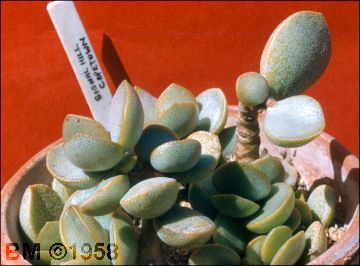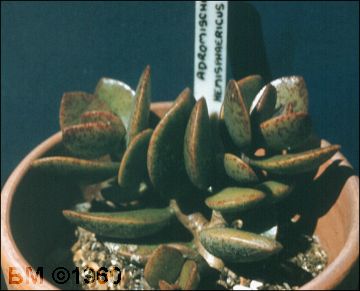From The
Cactulent: ADROMISCHUS HEMISPHAERICUS
Official
Bulletin of the London Cactus Club - October 1960 vol. 12 no. 6 p. 49-51
by Bryan Makin (Editor) [Other articles by BM on
this web site: White
Adromischus, A.
leucophyllus.]"Although I came across quite a
number of species of Adromischus growing
naturally in South Africa, the first one I
actually set out to find was that listed in the
local flora as A. rotundifolius. Since
then, I have learned that a complete range of
inter-grading forms exists along the west coast
of the Union, some of which have been given
specific names. But until the resultant mess has
been cleared up, I have chosen to stick to the
oldest relevant name, Adromischus
hemisphaericus, hence the apparent
contradiction between my opening remarks and the
title.
| A.
hemisphaericus can be found in a
small-leaved, rotund form on Signal Hill,
actually overlooking Cape Town itself,
and I have a nice pot-full in my present
collection. But, being ignorant of this
fact at the time, I chose the published
habitat of the Twelve Apostles [mountain
slopes] as the area for my search. I duly
left Cape Town by bus, travelling south
along the Cape Peninsula to the limit of
its local run, to the little coastal
village of Bakoven. This name is
pronounced BACK-OOF-N and its literal
translation is BAKE OVEN, so chosen
because of a peculiar hollow rock which
lies off shore shaped like the old Dutch
baking oven used by the early settlers. |

A. hemisphaericus
BM711, collected by H. Hall in 1958. |
In 1954, I
had started my outing directly after lunch and,
in the South African summer even on the coast,
the heat reflected up from the dry roadway at
this time of day can be very oppressive, and this
plus my recent meal, made me feel anything but
energetic. However, I turned my nose to the south
and continued along the roadway. The footpath
finished soon after leaving the bus. So, I had to
keep a wary eye and ear for traffic on the
twisting road. It unfailingly followed the
contour of the hills from which it had been cut
and fell away to the sea below on my left,
clothed in long trailing streamers of the giant
Mesemb, Carpobrotus edulis. The water
below was clear blue except where it lapped the
rocks. The door in the Oven was no longer visible
from where I stood. I looked around and the sandy
clay bank across the road rose sheer in parts for
ten, twelve, fifteen or more feet, but at others
showed possible footholds for an aspiring
ascendant.
Varying succulents
presented themselves at intervals, namely shrubby
Mesembs, occasional weedy-looking Crassulas, etc.
The most attractive was an Erepsia which was a
solid blaze of pink flowers and occurred
frequently along the roadside. My eyes were
constantly searching for succulents and
especially the Adromischus and suddenly I spotted
a plant on the edge of the vertical bank above
the road. Surely it was a Stapelia of some sort
and I cast about for a way up. It was a little
while before I found the plant again but, sure
enough, it was the well known S. variegata
to be precise, growing in short grass on the very
edge of the bank with its flower buds overhanging
the drop. None was open, but an investigation of
a large bud showed there was no doubt about its
identity. A few yards further along the road, I
found another S. variegata, on the other
side this time, growing deeply buried in almost
pure coarse sand in full sun! No sign of
Adromischus though and the sun was beginning to
weary me, so I turned and. retraced my steps,
having decided to explore higher up the lower
slopes of the Twelve Apostles range, as soon as I
could find a way up from the road.
These slopes were covered
in scrub bushes varying in height between one and
three feet with occasional clumps of the withered
leaves of bulbous plants that transform these
same hillsides into a pleasant colourful scene in
the beautiful Cape spring. But right now it was
the hot dry Cape summer and the only flowers were
those on the Erepsias and Carpobrotus, the latter
a pale straw yellow instead of the more
attractive magenta form. I scanned the slopes
somewhat forlornly now with the sun behind me
sinking lower into the western sky. A few
isolated boulders and rock outcrops gave a last
glimmer of hope and I picked my dusty way towards
each of them in turn. The first was bare and
unfruitful, but the second had a long crack
across the top overhung by a spreading bush. In
the shade of this bush and with its roots delving
into the crevice, was a beautiful blue mound of
that succulent composite, Kleinia repens.
How lovely it looked in its unblemished state
growing there on that hard granite-like rock of
Table Mountain Sandstone, but as I looked round
my exultation fell as I realised I had only a
couple of other rocks still to investigate. The
first was higher up the slope but seemed worth
the scramble since it was a sizeable boulder with
a few smaller rocks in attendance round it. I
finally stood before it and swept it with a
searching look. It had appeared grey and bare as
I approached, but now I could see a long sloping,
crevice some three or four feet in extent running
down the western face, and all along this crevice
were the thick stems and fleshy grey leaves of my
Adromischus. No opulent beauty this, no colourful
seeker after attention, but silvery-grey, scaly
leaves matching the colour of the rock itself and
asking for no-one's notice but that of the sun
and the rain in season.
In my album is a photograph
of that crevice with its Adromischus and in my
greenhouse is a pot with two labels. The newer
one reads "BM790 Adromischus
hemisphaericus", but the other says
"Adromischus rotundifolius,
collected Bakoven, Cape Peninsula, 1954".
The plant grows a little taller in cultivation,
up to about 5 in. and the leaves are less heavily
scaled and a bit larger than in the wild. They
vary according to age up to about 1 x 1½ in.
long, slightly concave on the front and rounded
on the back clothing the ascending stem. The
flower spikes rise in spring and open their
small, tubular blooms in mid-summer, the pale
"petals" being joined together and
fully recurved to clasp the tube. The species is
related to such other Adromischus as A.
bicolor, mammillaris, tricolor
and the recently named liebenbergii and fragilis.
| I have several
forms now, collected in different
localities, including one that becomes
almost white in the summer and another
that is covered in fewer scales but a
multitude of red spots. This latter came
from a place called Darling and makes a
very attractive plant. I have purposely
avoided all technicalities in this
account since the species and its
inter-grades are very much sub judice in
the taxonomic field. I would like however
to refer here to another plant so often
grown in collections as A.
hemisphaericus, but quite different
in appearance from the description I have
given. This is the low, squat, almost
stemless plant which is possibly the
commonest Adromischus in British
collections but which has thick, fleshy,
pointed leaves, much longer than broad,
tightly clustering and rarely, if ever,
blooming and certainly I have never seen
it in flower. In America, this used to be
known as "old mamillaria"
although not at all like the true A.
mammillaris. For years this plant
has remained an enigma, but it was
recently found again in the wild and has
been equated with A. vanderheydenii
n.n., which name I earnestly commend to
your attention. |

Possibly the spotted A.
hemisphaericus from Darling, BM655,
collected by H. Hall, plentiful on
granite outcrop. |
Finally, a
word on cultivation: A. hemisphaericus is
a very accommodating plant but does best with a
restricted diet and the maximum sunshine to
encourage the production of the silvery scales on
the otherwise green leaves. I like to grow mine
in an open cold frame in summer and find they
propagate easily from leaves."
|